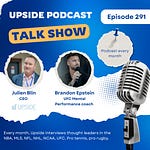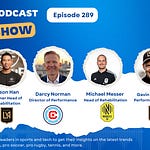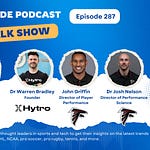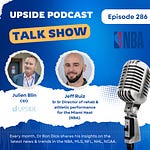Today we have the honor to interview a interviewing a group of sports performance experts (MLS, Ligue 1, NHL, NFL).
Rick Cost, the High Performance Director at l’Olympique Lyonnais (Ligue 1 team).
Alexi Pianosi, the head of S&C conditioning coach for the Colorado Avalanche (NHL team).
Karam Al Hamdani , the director of sports medicine at CF Montreal (MLS team).
Adam Quigley, an experienced athletic trainer in the MLS (LA Galaxy), NFL (Saints) & US Soccer national teams.
Through the interview we touched on the following questions:
Mental preparation: How are MLS and Ligue 1 clubs, NHL approaching the mental and cognitive aspects of performance in 2025—especially given the high-pressure environments and the younger player profiles coming through?
Injury reduction: What are the biggest lessons or surprises your clubs have learned over the past year when it comes to injury reduction—anything that challenged traditional beliefs or changed internal protocols?
Change of Direction (CoD): Change of direction ability is critical in soccer, yet many clubs still struggle to accurately assess and train it. What are the biggest challenges you've faced in capturing CoD metrics in the field—and why is improving this capacity so essential to injury prevention and performance?
Pain management: Pain management is evolving fast, with everything from red light therapy to neuromodulation gaining traction. What are the most effective modalities you've personally seen make a difference in your athletes’ recovery and performance—and how do you decide which tool to use and when?
FIFA Club World Cup: With the FIFA Club World Cup kicking off this month and featuring top clubs from every continent, which team do you see standing out—and what performance trends or tactical evolutions are you most curious to observe during the tournament?
You can watch the video interview below by clicking on the Youtube link. You can also listen to the audio interview by clicking on the link at the top of the page:
xxx
You can read the full transcript of the podcast interview with Rick, Alexi, Karam, and Adam located at the top of this blog post.
Here are the quotes from the interview with them:
Q1: Mental and Cognitive Aspects of Performance
Rick Cost:
“We’re really at the beginning stages of integrating cognitive and mental performance more deeply into our player evaluation and development. It starts on the scouting end — we’re now looking beyond just technical skills and physical abilities and evaluating players' mindsets. We use specific questionnaires where players rate themselves on items like mental resilience, leadership, growth mindset, and adaptability. Then we cross-check their answers with feedback from coaches or people who know them well to look for discrepancies or alignment. Once the players are in, we create individualized goals based on their scores and reassess every three months. This helps us guide them in areas like leadership development or mental toughness. What’s fascinating is seeing how eager some players are to engage with this process — many really want to grow in this area. It’s still very new, especially compared to my previous experiences in the U.S. or the Netherlands, but there’s a clear appetite for it.”
Alexi Pianosi:
“At the NHL level, I think we’re seeing more and more players privately seeking out their own mental performance coaches or psychologists, often through personal networks. The challenge at the team level is trust — players might be hesitant to open up to someone affiliated directly with the organization. My approach is to normalize these conversations about growth mindset, process orientation, and resilience, much like we do with strength training or nutrition. Instead of mandating sessions, I try to create an environment where mental skills are valued and discussed openly — sharing articles, anecdotes, or research to spark interest. That way, when a player feels ready, they know these resources exist and can engage in a way that feels safe and voluntary.”
Adam Quigley:
“It’s interesting to reflect on how these roles have evolved. Historically, staff like us were often the de facto mental therapists — players would bring their personal issues to us because we were trusted support figures. Now, as clubs bring in dedicated mental performance coaches or sports psychologists, there’s a transition happening. We’re figuring out how to integrate both roles and create standardized assessments while still respecting individual privacy and needs. Beyond cognitive performance, there’s the emotional health side — a player whose partner is pregnant and struggling to sleep, for example, may have very different needs than someone working on reaction time or decision-making. It’s a complex space where trust, timing, and individualization are absolutely critical.”
Karam Al Hamdani:
“The trust element is huge. Players may perceive working with a mental coach employed by the club as a vulnerability, worrying about how information might be shared with upper management. From my perspective, it’s always about the player's wellbeing — I’m here to help them perform at their best, whether physically or mentally. Seeking mental support shouldn’t be seen as weakness; if anything, it takes great strength to acknowledge where you need help and be proactive about it.”
Q2: Injury Reduction Lessons
Karam Al Hamdani:
“One of the biggest lessons I’ve learned is how multifactorial injury risk truly is. We often fixate on GPS data — how much they run, sprint distance, high-speed efforts — but that’s just one part of the picture. Sleep quality, hydration, emotional stress, contract negotiations, HRV, mental state — all these factors matter. Sometimes everything looks perfect on paper — all the data says they should be ready — and yet they still get injured. We had a player last year who suffered a minor adductor strain, went through flawless rehab, passed all our objective measures, yet reinjured the same muscle minutes into his first game back. It’s a reminder that despite all our technology, there are still elements of randomness and unpredictability we cannot fully control.”
Rick Cost:
“The only thing that’s truly challenged my understanding isn’t a new technology — it’s the concept of entropy in movement. Stable systems create predictable patterns, but when things become disorganized — due to poorly timed training loads, poorly sequenced strength sessions, or even subtle fatigue — we see players start to drop with soft tissue injuries like hamstring strains. We still don’t have reliable ways to measure this movement variability in real time, but I believe if we can eventually quantify ‘system entropy’ — the underlying stability of the neuromuscular system — it might unlock an entirely new way to understand injury risk.”
Adam Quigley:
“The biggest unknown right now is how to synthesize all the available data into something actionable in real time. There are vendors working on predictive models that claim they’ll soon be able to say, ‘This player is entering a danger zone — pull them now.’ But even if we develop that capability, ultimately the coach and medical team will still need to make tough decisions: Is it worth pulling a star player in the 4th quarter? Human judgment will always play a role.”
Q3: Challenges in Measuring and Training Change of Direction (CoD)
Alexi Pianosi:
“In hockey, change of direction is very different than most sports because you’re not on solid ground — you’re on skates with less friction, different biomechanics, and wearing significant gear. You also rarely change direction repeatedly without a puck or without reacting to a defender. So, isolated drills don’t always translate well. What we do is study high-performing players — how they pivot, accelerate, and stop under pressure — then we try to replicate and strengthen the qualities that enable those movement patterns in off-ice training. For players who are already world-class, it's often about refining very specific elements of their game based on their role.”
Rick Cost:
“When I was growing up, kids played endless games of tag, capture the flag, dodgeball — all requiring constant change of direction. That spontaneous, unstructured agility has been lost with today’s youth spending more time behind screens. We became obsessed with high-speed running metrics and linear conditioning, often neglecting the type of multi-directional agility that once came naturally. Now we’re realizing how much we’ve lost. Fortunately, there’s renewed focus on re-integrating these drills — curvilinear runs, T-drills, quick reactive drills — back into warm-ups and training. It’s almost like rediscovering what we already knew decades ago.”
Q4: Pain Management Modalities
Karam Al Hamdani:
“One of the biggest things I’ve learned recently is how much of pain management comes down to coaching the brain to remove the threat response. We had a player who took a bad bruise to the calf — couldn’t walk initially — but through guided movement, dorsiflexion, and progressive load coaching, combined with compression and constant flushing, we convinced his brain it was safe to move again. He played the next day. Neuromodulation isn’t always about fancy machines — sometimes it’s about reframing the perception of danger.”
Alexi Pianosi:
“You have to distinguish between discomfort and pain rooted in pathology. A stiff back may just need some soft tissue work and mobility, but a tibial plateau bruise that hurts with every plant could increase injury risk dramatically. That’s where pain becomes a movement quality issue, not just a symptom. Modalities like red light, cryo, or compression sleeves are tools to support recovery and comfort, but they don’t resolve the underlying injury.”
Adam Quigley:
“I’ve started looking at pain management more holistically — not just what happens in the treatment room, but how athletes spend the rest of their day. Can they stay active with safe alternatives? Can they stay engaged with their team socially and mentally? The more we keep athletes mentally stimulated and involved, the less consumed they become by the pain itself.”
Rick Cost:
“Players often request treatments based on what worked for them previously. One might swear by infrared therapy, another by compression sleeves. Whether or not these modalities have strong scientific backing, the psychological trust factor is huge. If the athlete believes it helps, sometimes that’s just as important as the intervention itself.”
Q5: FIFA Club World Cup Performance Trends
Adam Quigley:
“What makes this tournament so fascinating is how these completely different tactical styles will clash. MLS clubs rarely face the same level of high-pressing, technically dominant teams like PSG or Manchester City. It’ll be a real test of adaptability — how quickly coaches can adjust mid-match when their initial game plan isn’t working. The MLS sides will take this extremely seriously — it’s a rare chance to prove themselves on a global stage.”
Rick Cost:
“In Europe, the high press has evolved into more of a mid-block, with strikers sitting a bit deeper to conserve energy for decisive moments. MLS teams often press much higher and with more energy, which could be risky against teams who excel at playing through pressure. Add in the variables of heat, humidity, altitude, and heavy travel — especially for European clubs unaccustomed to this — and you’ve got a very unpredictable environment. I’m especially curious to see which young players break through in this setting.”
You may also like:












